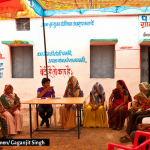
India’s Anti-Corruption Agency in the Global Integrity Report 2009
6 July 2017
The Global Integrity (GI) Report 2009 rates India as moderately capable of handling the “cancer” of corruption (70 on 100). With its legal framework scoring 86 (strong), India’s actual implementation of accountability mechanisms and transparency is only 55 (very weak) leaving a very large implementation gap of 31. Unlike other corruption indices, the GI Index does not measure corruption, but using responses to 300+ Integrity Indicators, it assesses “the access that citizens and businesses have to a country’s government, their ability to monitor its behaviour, and their ability to seek redress and advocate for improved governance” as a measure of a government’s ability to prevent abuse of power and promote public integrity.
The Anti-corruption and Rule of Law category of the Indicators shows that India’s strong anti-corruption laws (score: 89) are made ineffective by a weak anti-corruption agency (score: 69), weak rule of law (score: 67) and very weak law enforcement (score: 58).
More than a decade after the Supreme Court (SC) gave extensive directions to the government in the landmark Vineet Narain case to secure the independence of the Central Bureau of Investigation (CBI) and the Enforcement Directorate, the governments in power continue to manipulate the CBI and the legal processes instead of consistently upholding the rule of law.
Why anti-corruption agencies (ACAs) fail has been well documented through the experiences of many countries. Fear of consequences that lead to loss of independence and autonomy, unrealistic expectations when fighting deeply entrenched systemic corruption, excessive reliance on enforcement after the event, lack of public involvement, insufficient accountability, are some of the reasons of failure frequently cited.
These causes may well apply to ACAs in India because the flaws are largely institutional. Independence and autonomy of the CBI is a myth. The CBI still must get permission from the government to register cases (under certain situations) and sanction for prosecution of corruption cases against public servants. The Criminal Procedure Code makes it essential for the CBI to take permission of the government before it can appeal to a higher court against a case lost in the trial court. Senior level police officers in the CBI belong to the Indian Police Service who owe their allegiance to the government who appoint and can remove them from service.
Despite its claim to a “three pronged strategy for prevention, surveillance and detection as well as deterrent and punitive action” to contain corruption, the preventive vigilance functions of the ACAs (which in the Central government is a multi-agency combined force of the Department of Personnel & Training (DoPT), Central Vigilance Commission (CVC), CBI and Chief Vigilance Officers (CVOs) is virtually non-existent. Asset declaration religiously gathered and filed by the government departments is a good example. Low registration of cases and low conviction rates point as much to poor vigilance as to ineffective investigation and prosecution.
The SC perhaps tried to create a powerful single agency by its 1997 judgment endowing the CVC with powers of supervision and control over vigilance administration and corruption cases and also over CBI investigations. As a statutory body answerable to the Parliament, the SC directives were intended to insulate appointments, investigation and prosecution from government control, read the DoPT. This experiment with independence has nearly failed.
But the single-agency approach appears to have worked for South Korea, which the GI Report rates as the most capable of all the 35 countries assessed to fight corruption. It not only scores full marks for its AC law, but its ACA is rated as strong (an Independent Commission that reports to the President), as is its law enforcement. A powerful centralized agency that has also worked excellently is Hong Kong’s (not part of the GI Report) Independent Commission Against Corruption whose mission is to prosecute the “big fish” in combination with encouraging citizen involvement in oversight and reporting of corruption cases.
In attempting to create a single agency system, was the SC relying far too much on independence and autonomy? Interestingly, studies show that accountability and formal independence, though desirable, are overrated because they can be so easily subverted by political factors. This seems to be borne out by the GI data which show that ACAs of a large number of countries like India, Algeria, Columbia, Venezuela, Indonesia, Jordan, Kenya, Nepal, which are in law protected from political interference, fare poorly when it comes to actual practice. The United States on the other hand, without any formal law, scores highly in insulating its ACA.
Effective laws, procedures, courts system, and financial system governance have been found to make ACAs successful. The experiences of Hong Kong have shown that public and civil society participation to eradicate corruption are effective strategies. As are freedom of information laws.
Collecting and publishing performance data is sine qua non for analysing performance of ACAs. Unfortunately, so little of it is available on India. For example, once too often CBI announces countrywide raids to catch corrupt public officials, but there is rarely any information on the follow-up. Given the low levels of cases which actually to go trial, it is doubtful that CBI puts its raid data to effective use. Looking inwards is the only way India’s ACAs can shed their public image that they exist only to shield the corrupt.
Madhumita D. Mitra is a Consultant with Corporate Lexport, a law firm based in New Delhi





